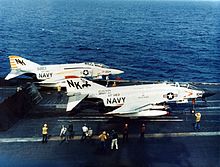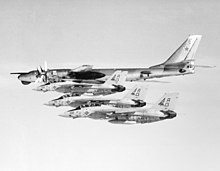Strike Fighter Squadron 143 (VFA-143), also known as the "Pukin Dogs," is a United States Navy strike fighter squadron based at Naval Air Station Oceana, Virginia. The Pukin Dogs are an operational fleet squadron and flying the F/A-18E Super Hornet. They are currently attached to Carrier Air Wing One and USS Harry S Truman. They are currently at their homeport of NAS Oceana. Their radio callsign is Taproom.
Insignia and nickname
The squadron adopted its current insignia in 1953, a winged black griffon on a blue shield. The distinctive squadron name "Pukin' Dogs" came about when the squadron commander's wife saw the creature’s droopy head and gaping mouth design. She stated, in front of the squadron pilots, that it looked like a "pukin' dog." The pilots loved that, and the name stuck. In the aftermath of the Tailhook scandal in 1991, the squadron was forced to officially rename itself the "Dogs". This official banishment was widely ignored until Admiral John Mazach, Commander, Naval Air Force U.S. Atlantic Fleet, rescinded the policy in a 1996 speech to the squadron.
History
Two Navy squadrons have held the designation VF-143. The first VF-143 was established on 20 July 1950 as VF-821 redesignated VF-143 on 4 February 1953 and disestablished on 1 April 1958. The second VF-143 was established in 1950, was eventually redesignated VFA-143, and is the subject of this article.
1950s

VF-871, a reserve F4U-4 Corsair squadron based at NAS Alameda called to active duty on 20 July 1950. The squadron deployed twice during the Korean War, flying from the aircraft carriers USS Princeton from 31 May to 25 August 1951 and USS Essex from 16 June 1952 to 6 February 1953. On 4 February 1953, the squadron was redesignated VF-123 and transitioned to the F9F-2 Panther. In April 1958 they transitioned to the F3H Demon and were redesignated VF-53.
1960s

On 20 June 1962, the unit was redesignated VF-143 and began its transition to the F-4 Phantom II. They deployed seven times during the Vietnam War.
The squadron deployed on USS Constellation from 5 May 1964 to 1 February 1965. The squadron deployed on USS Ranger from 10 December 1965 to 25 August 1966. The squadron deployed on USS Constellation again from 27 April to 4 December 1967. On 26 October LTJG R. Hickey and LTJG J. Morris shot down a MiG-21. The squadron deployed on USS Constellation again from 29 May 1968 to 31 January 1969. The squadron deployed on USS Constellation again from 11 August 1969 to 8 May 1970.
1970s
The squadron deployed on USS Enterprise from 11 June 1971 to 12 February 1972.
VF-143's last Vietnam deployment began on 12 September 1972 onboard USS Enterprise. On 27 January 1973, the last day of official hostilities before the Paris Peace Accords took effect across Vietnam, a squadron Phantom was struck by antiaircraft fire over Quảng Trị Province while performing one of the last combat missions of the war in support of the Battle of Cửa Việt. The squadron's executive officer, Commander Harley Hall, and his radar intercept officer (RIO) ejected near the coast and both were seen alive on the ground by their wingman. The RIO was captured by North Vietnamese and returned from captivity a few months later. Hall became the last Naval Aviator listed as missing in action (MIA). Two weeks after the shoot down, however, his status was changed from MIA to "prisoner of war (POW), authenticated", a designation held until he was declared deceased in February 1980. His remains were identified on 6 September 1994.

The squadron returned to NAS Miramar on 12 June 1973, and three months later made a final Phantom deployment to the Mediterranean. In 1974, VF-143 transitioned to the F-14 Tomcat and then changed homeport to NAS Oceana in 1976. VF-143 and its sister squadron VF-142 were aboard USS America for her maiden voyage in 1976.
1980s

In 1980 VF-143 deployed to the Indian Ocean in response to the Iran–Iraq War, setting a Navy underway record of 153 days. VF-143 soon gained Tactical Air Reconnaissance Pod System (TARPS) capability, and provided the first time imagery of the new Soviet aircraft carrier Novorossiysk and the new Soviet Slava-class cruiser. On 5 August 1983, VF-143 intercepted five Libyan Air Force MiG-23s some 220 kilometers (140 mi) south of USS Dwight D. Eisenhower in the Mediterranean Sea. No weapons were fired during these encounters but the situation was described as "very tense". The squadron became the first to fly combat TARPS missions when they flew 45 combat reconnaissance sorties over Lebanon in the autumn of 1983.
1990s

VF-143 was one of the first squadrons to deploy with the F-14A(+) (later renamed F-14B), in March 1990 aboard USS Dwight D. Eisenhower. When Iraq invaded Kuwait in August 1990, USS Dwight D. Eisenhower and her battle group rushed to the Red Sea to deter the Iraqis from further advancement into Saudi Arabia. In late August, USS Saratoga relieved USS Dwight D. Eisenhower .
In early 1991, VF-143 was awarded COMNAVAIRLANT's 1990 Battle Efficiency Award as the Atlantic Fleet's finest fighter squadron. In addition, VF-143 was awarded the Chief of Naval Operations Rear Admiral Joseph C. Clifton Award. In May 1991 during the Air Wing's detachment to NAS Fallon, VF-143 dropped air-to-ground ordnance for the first time. In September, the squadron deployed to the Persian Gulf, and participated NATO exercises in the Norwegian Sea.
In August 1992, the squadron and the rest of Carrier Air Wing Seven switched aircraft carriers to USS George Washington, the Navy’s newest aircraft carrier. VF-143 deployed for USS George Washington's maiden cruise and then again for the carrier’s first Mediterranean Sea deployment in May 1994 where she took part in the 50th anniversary commemoration of the D-Day invasion and Operation Deny Flight. VF-143 returned to NAS Oceana in December 1994. VF-143 was awarded the 1994 Battle E, Safety S, Joseph C. Clifton and Golden Wrench awards.
In January 1996, VF-143 departed on their second deployment in thirteen months, operating in support of Operation Decisive Endeavour and Operation Southern Watch. The squadron provided TARPS, Forward Air Controller, air superiority and air-to-ground missions. VF-143 returned to Oceana in July 1996.
In early 1997, VF-143 transitioned to the Navy's newest carrier, USS John C. Stennis, deploying in 1998. The maiden deployment took them to the Persian Gulf, spending 131 days there in support of Operation Southern Watch. VF-143 played key roles using LANTIRN, night vision goggles and digital TARPS. VF-143 was recognized by COMNAVAIRLANT with the 1998 Battle "E" Safety "S" awards.
2000s

VF-143 deployed in support of Operation Southern Watch, Operation Enduring Freedom and Operation Iraqi Freedom. The last deployment with the F-14 was in 2004 aboard USS George Washington in support of Operation Iraqi Freedom, during which time the squadron participated in strikes over Fallujah between 28 April – 29 April.
In 2005 VF-143 transitioned to the F/A-18E Super Hornet, and was designated Strike Fighter Squadron 143 (VFA-143).
The first deployment with the F/A-18E commenced in 2006 and ended in the spring of 2007. During the cruise aboard USS Dwight D. Eisenhower, VFA-143 supported Operations Iraqi Freedom, Enduring Freedom and operations off the Somali coast.
On 21 February 2009 VFA-143 and CVW-7 embarked aboard USS Dwight D. Eisenhower for a deployment supporting Operation Enduring Freedom and maritime security operations in the Persian Gulf. On 30 July 2009, USS Dwight D. Eisenhower returned to Naval Station Norfolk after almost a six-month deployment.
2010s

VFA-143 and the rest of CVW-7 embarked on board USS Dwight D. Eisenhower on 2 January 2010 for a seven-month deployment in support of 5th and 6th Fleet operations. The "Pukin' Dogs" won the 2010 Wade McClusky Award, as most outstanding attack squadron in the US Navy, for its performance during this deployment. In June 2012, VFA-143 deployed again on board Dwight D. Eisenhower for a nine-month deployment in support of Operation Enduring Freedom. That deployment was cut short due to the requirement for entire Carrier Strike Group to surge. Dwight D. Eisenhower returned to Naval Station Norfolk just prior Christmas in December 2012. The Air Wing re-embarked on Dwight D. Eisenhower and got underway in February 2013 for a five-month surge deployment, again in support of Operation Enduring Freedom.
After a two-year maintenance period, the "Pukin' Dogs" and the rest of CVW-7 embarked on board USS Harry S. Truman on 15 November 2015 for a seven-month deployment in support of Operation Inherent Resolve. CVW-7 dropped a record breaking number and tonnage of ordnance on targets in the vicinity of Fallujah, Ramadi, and Mosul Iraq. As well as support coalition forces in western Syria. VFA-143 dropped 422 precision guided weapons, totaling nearly 400,000 pounds of ordnance. After being extended for a month, VFA-143 returned to NAS Oceana Virginia on 12 July 2016.
After 45 years with CVW-7, the squadron was transferred to Carrier Air Wing One as of October 2023.
See also
- Naval aviation
- Modern US Navy carrier air operations
- List of United States Navy aircraft squadrons
- List of Inactive United States Navy aircraft squadrons
External links
References
- Carrier Air Wing 7 Begins OEF Missions Archived 6 February 2012 at the Wayback Machine
- ^ "Strike Fighter Squadron ONE FOUR THREE [VFA-143]". US Navy. Retrieved 30 December 2006.
- ^ Grossnick, Roy A.; Evans, Mark (2016). United States Naval Aviation, 1910-2010 (PDF). Naval History and Heritage Command. ISBN 9780945274759.
 This article incorporates text from this source, which is in the public domain.
This article incorporates text from this source, which is in the public domain.
- Marolda, Edward (1996). By Sea, Air, and Land: An Illustrated History of the U. S. Navy and the War in Southeast Asia. DIANE Publishing. ISBN 9780788132506.
- "U.S. Accounted-For from the Vietnam War" (PDF). Defense POW/MIA Accounting Agency. Retrieved 22 December 2015.
- Libyan Wars, 1980-1989, Part 3 - Operation "Manta" By Tom Cooper Archived 2 February 2010 at the Wayback Machine
- Holmes, Tony (2005). US Navy F-14 Tomcat Units of Operation Iraqi Freedom. Osprey Publishing Limited. p. 87.
- CVW-7 Sailors Complete an Eight-Month Deployment Archived 29 March 2012 at the Wayback Machine
- - Eisenhower Carrier Strike Group Deploys
- Prince, Adam (22 February 2009). "Eisenhower Carrier Strike Group Deploys" (PDF). USS Dwight D. Eisenhower (CVN 69). Retrieved 23 February 2009.
- "IKE Strike Group Deploys". United States Navy. 2 January 2010. Retrieved 2 January 2010.
- Jones, Lt. Brian (26 October 2011). "VFA-143 Pukin' Dogs receive Wade McClusky Award". The Flagship. Military Newspapers of Virginia. Retrieved 23 September 2020.
- "Comnavairlant".
| Active United States Navy Aircraft Squadrons | |||||
|---|---|---|---|---|---|
| Electronic Attack (VAQ) | |||||
| Carrier Airborne Early Warning (VAW) | |||||
| Strike Fighter (VFA) | |||||
| Fleet Air Reconnaissance (VQ) | |||||
| Fleet Fighter Composite (VFC) | |||||
| Fleet Logistics Support (VR) | |||||
| Carrier Fleet Logistics Support (VRC) | |||||
| Carrier Fleet Logistics Multi-Mission (VRM) | |||||
| Patrol |
| ||||
| Unmanned (VUP) | |||||
| Training (VT) | |||||
| Helicopter Mine Countermeasures (HM) | |||||
| Helicopter Sea Combat (HSC) | |||||
| Helicopter Maritime Strike (HSM) | |||||
| Helicopter Training (HT) | |||||

